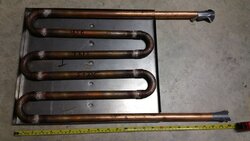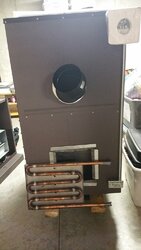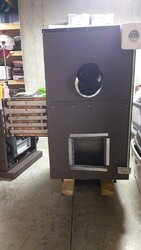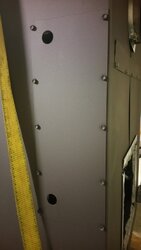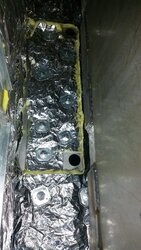Hi Folks, I have been lurking for awhile trying to learn and thought I would post here and see if some good advice would come my way.
I bought a house this summer on about 14 acres that has a electric heat pump as the main source of heat, a non-vented aesthetic propane heater, and no wood or other heat option. I want to add heat from wood into the house. I just ordered parts for a 6" chimney flue which is insulated Class A and it will be through the wall of my walk out basement and then up 28 feet with one pair of 15 degree elbows for the eave.
The walk out basement is about 1356 sq feet with the same living space above it on the main level. The basement ceiling is unfinished and it is just subfloor and a wood laminate type flooring so thus no insulation. There is a cathedral ceiling A frame style above half of the house and then a second floor of 680 square feet has a hallway that opens up to the open air space. So any heat on the main level will easily rise and heat the two bedrooms upstairs. It appears well insulated with 2x6 exterior wall construction although the 12" block wall in the basement is not insulated. The stairway up from the basement is centered in the middle of the main level so if that door was open, then heat could flow up the stairway.
Now with all of that said, I am having trouble deciding what type of wood stove or forced air furnace to purchase. I have thought of a simple wood stove in the basement to heat up that area as that is where we have a den with TV and so forth and then warm area would heat the floor and flow up the stairway. We are often gone all day except weekends and so it is mostly for supplemental heat while we are home and to keep the electric bill lower. Something with long burn times might be good. I would love to have a good way of heating domestic hot water for we have a large jacuzzi tub and I hate using our propane hot water heater to heat all that water. At some point I would love to add a hot tub and figure out a way to heat that with wood as well. Most simple wood stoves I have seen have no DHW option. I want something to heat the house if power is out and blowers are not working.
I have wondered about a furnace such as the Max Caddy with good looking hot water coils but it is at the upper edge of what I would like to spend money wise. I might go that direction but my funds are limited at the moment. If I bought a standard type wood stove, I could later put that in my insulated garage. I hear the Kuuma has a domestic HW coil but no idea how large it is and that furnace seems very pricey.
Right now I have zero firewood on hand but I know how to make that change quickly. Even so this winter I do not expect to have really well seasoned firewood on hand. Other years should be better.
Any thoughts on particular wood stoves or furnaces? I was not sure which thread category to stick this post.
I bought a house this summer on about 14 acres that has a electric heat pump as the main source of heat, a non-vented aesthetic propane heater, and no wood or other heat option. I want to add heat from wood into the house. I just ordered parts for a 6" chimney flue which is insulated Class A and it will be through the wall of my walk out basement and then up 28 feet with one pair of 15 degree elbows for the eave.
The walk out basement is about 1356 sq feet with the same living space above it on the main level. The basement ceiling is unfinished and it is just subfloor and a wood laminate type flooring so thus no insulation. There is a cathedral ceiling A frame style above half of the house and then a second floor of 680 square feet has a hallway that opens up to the open air space. So any heat on the main level will easily rise and heat the two bedrooms upstairs. It appears well insulated with 2x6 exterior wall construction although the 12" block wall in the basement is not insulated. The stairway up from the basement is centered in the middle of the main level so if that door was open, then heat could flow up the stairway.
Now with all of that said, I am having trouble deciding what type of wood stove or forced air furnace to purchase. I have thought of a simple wood stove in the basement to heat up that area as that is where we have a den with TV and so forth and then warm area would heat the floor and flow up the stairway. We are often gone all day except weekends and so it is mostly for supplemental heat while we are home and to keep the electric bill lower. Something with long burn times might be good. I would love to have a good way of heating domestic hot water for we have a large jacuzzi tub and I hate using our propane hot water heater to heat all that water. At some point I would love to add a hot tub and figure out a way to heat that with wood as well. Most simple wood stoves I have seen have no DHW option. I want something to heat the house if power is out and blowers are not working.
I have wondered about a furnace such as the Max Caddy with good looking hot water coils but it is at the upper edge of what I would like to spend money wise. I might go that direction but my funds are limited at the moment. If I bought a standard type wood stove, I could later put that in my insulated garage. I hear the Kuuma has a domestic HW coil but no idea how large it is and that furnace seems very pricey.
Right now I have zero firewood on hand but I know how to make that change quickly. Even so this winter I do not expect to have really well seasoned firewood on hand. Other years should be better.
Any thoughts on particular wood stoves or furnaces? I was not sure which thread category to stick this post.


 I would drive a couple hours to look at some furnaces if I knew of a great place.
I would drive a couple hours to look at some furnaces if I knew of a great place.